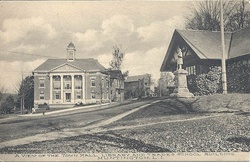20th Century Growth

The years around the turn of the twentieth century also saw the construction of Huntington’s civic core. The town’s first library was built in 1892. The first Town Hall was built in 1910. At the same time, a new high school building was being constructed near the site of the first schoolhouse. That building now serves as Town Hall. A new, modern firehouse was built the following year. Civic pride in the community’s past was celebrated in a grand celebration of the Town’s 250th anniversary in 1903—an event that led to the formation of the Huntington Historical Society.
By the early twentieth century thousands of acres of productive farmland were laying fallow because the land had been appropriated for large estates. Marshall Field, Robert DeForest, Otto Kahn, Charles Gould, August Heckscher, George McKesson Brown, Walter Jennings, Roland Conklin and many others extended Long Island’s Gold Coast into Huntington. The middle class was also attracted to Huntington. Summer bungalow communities developed along the shores of Centerport Harbor, Huntington Bay and Huntington Harbor during the 1920s.
From 1920 to 1930, Huntington’s population increased 84% from 13,893 to 25,582. Huntington village began to take shape with one large building project after another along New York Avenue: The Palace Theatre in 1917, the Huntington Theatre and Huntington Office Building in 1927, The Huntington Mortgage Building in 1928 and the Hotel Huntington in 1929.
This explosive growth slowed considerably during The Great Depression. This break provided an opportunity for the Town to implement zoning and building codes in an attempt to manage growth, which returned with a vengeance after World War II. From 1950 to 1960, the Town’s population increased 165% and then another 58% from 1960 to 1970. In just twenty years, Huntington grew from 47,506 residents to 199,486. Where the railroad had spurred growth and commerce in the mid-nineteenth century, the Long Island Expressway served the same purpose almost 100 years later.
This growth led to the need for new schools. Before the war, Huntington’s students graduated from one of three high schools. Today, there are eight. Residents saw a greater need for parks. A referendum in 1962 led to the acquisition of hundreds of acres of parkland. Beaches and golf courses were built. Programs, such as the popular summer concert series in Heckscher Park, were established.
Suburbanization brought regional and local shopping centers built to attract shoppers traveling by car rather than on foot. In response to this threat to the town’s traditional downtown shopping districts, the Town instituted an Urban Renewal program. While the program saw some success in Huntington village, Huntington Station was decimated. Ongoing efforts to reclaim the Station continue.
The once quiet farming area in Melville was re-imagined as a commercial center. In the 1960s, the Chamber of Commerce led efforts to attract light industry and corporate offices to Huntington to help alleviate the tax burden on local residents due to the need for new schools and other public services caused by the growing population. Today the Route 110 corridor in Melville is considered Long Island’s business downtown.
Despite the threat posed by automobile-centered shopping centers, Huntington’s downtown business districts have thrived. Seen as models of walkable communities, they continue to attract visitors from across Long Island. The vibrant cultural scene in Huntington village—featuring a Fine Arts museum, independent cinema, first class concert venue, and local galleries, as well as superb restaurants, has earned Huntington village the nickname “The Little Apple.”